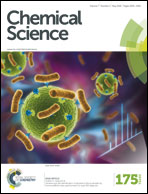Direct observation by time-resolved infrared spectroscopy of the bright and the dark excited states of the [Ru(phen)2(dppz)]2+ light-switch compound in solution and when bound to DNA†
Abstract
The [Ru(phen)2(dppz)]2+ complex (1) is non-emissive in water but is highly luminescent in organic solvents or when bound to DNA, making it a useful probe for DNA binding. To date, a complete mechanistic explanation for this “light-switch” effect is still lacking. With this in mind we have undertaken an ultrafast time resolved infrared (TRIR) study of 1 and directly observe marker bands between 1280–1450 cm−1, which characterise both the emissive “bright” and the non-emissive “dark” excited states of the complex, in CD3CN and D2O respectively. These characteristic spectral features are present in the [Ru(dppz)3]2+ solvent light-switch complex but absent in [Ru(phen)3]2+, which is luminescent in both solvents. DFT calculations show that the vibrational modes responsible for these characteristic bands are predominantly localised on the dppz ligand. Moreover, they reveal that certain vibrational modes of the “dark” excited state couple with vibrational modes of two coordinating water molecules, and through these to the bulk solvent, thus providing a new insight into the mechanism of the light-switch effect. We also demonstrate that the marker bands for the “bright” state are observed for both Λ- and Δ-enantiomers of 1 when bound to DNA and that photo-excitation of the complex induces perturbation of the guanine and cytosine carbonyl bands. This perturbation is shown to be stronger for the Λ-enantiomer, demonstrating the different binding site properties of the two enantiomers and the ability of this technique to determine the identity and nature of the binding site of such intercalators.
![Graphical abstract: Direct observation by time-resolved infrared spectroscopy of the bright and the dark excited states of the [Ru(phen)2(dppz)]2+ light-switch compound in solution and when bound to DNA](/en/Image/Get?imageInfo.ImageType=GA&imageInfo.ImageIdentifier.ManuscriptID=C5SC04514B&imageInfo.ImageIdentifier.Year=2016)
- This article is part of the themed collection: Celebrating the 2016 RSC Prize and Award Winners


 Please wait while we load your content...
Please wait while we load your content...